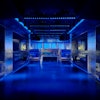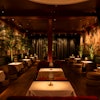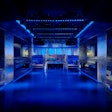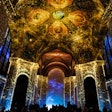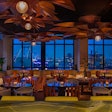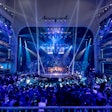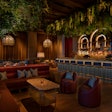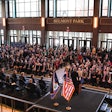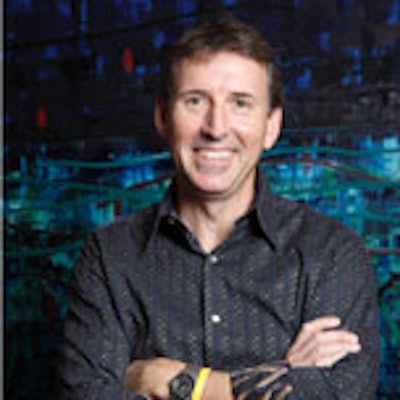
Photo: Francine Daveta for BizBash
Jeff Earl
Title: Director of event planning, News Corporation
What He Does: Earl oversees 25 to 30 events per year, including a shareholder meeting, executive and board dinners, movie screenings, internal employee functions (blood drives, educational events), and internal and external meetings for top executives, including C.E.O. Rupert Murdoch. He’s currently planning the employee holiday party for 6,000 New York-based employees and spouses.
Staff: “I’m a department of one, but I get support from our corporate communications, internal communications, and human resources groups. I hire freelancers to assist and rely heavily on event and production companies for some events.”
Budget: “On a regular year, two to three million dollars, depending on what’s going on.”
Age: 47
Career Path: He majored in sociology with a criminology concentration at the University of Minnesota, Duluth, and then worked as a corrections counselor at a maximum-security juvenile detention center. (“At one point I was going to save the world, but I wasn’t the right person to do it.”) His first exposure to meetings came when he was an account exec for a corporate travel agency. His initial foray into events was in 1994, working as transportation manager for the New York/New Jersey host operations during the FIFA World Cup soccer tournament. He freelanced in a slew of event jobs, including some for TV Guide, which eventually brought him on full-time in 2000. Two years later, he moved into his current role at News Corp.
Where He Lives: TriBeCa
Where He Grew Up: Minnesota
Best Tip: “If you can’t trust the people you’re working with, replace them with a team you can rely on.”
Favorite Drink: A cold beer of any sort.
Favorite Vendor: “My favorite DJ right now is DJ Shawn, who filled in at one of our Pebble Beach events when the celebrity DJ’s flight got cancelled. He had worked an event the prior night and happened to still be on-site. He saved the day and spun some great tunes.”
Favorite Newspaper: “The New York Post,” he says, of course, adding, “I also read The New York Times every day.”An article in the U.K. newspaper The Observer called the star-studded July powwow in Pebble Beach “one of the most important annual gatherings in News Corp’s history.” Why was this event so important?
The last time we convened a meeting of the top executives from our companies around the world was in 1998, so it had been eight years since the last gathering. As widespread and diverse as we are, the execs do not interact on a regular basis. We have added a lot of great properties in that time: DirectTV, SKY Italia, Fox Interactive Media, which includes the new Internet companies, to name a few. It was important to build and enhance relationships between these executives.
How did you begin the planning process?
Peter Chernin, News Corporation’s president and chief operating officer, came up with the [theme] of “Imagining the Future.” We didn’t want to do something that was focused on the day-to-day business of the company. These are executives who either produce their own events or have been to fantastic events throughout their career, so we were trying to do something different than sitting in a boardroom and talking about News Corp for four days. We wanted to send our people home with more of a global perspective, give them ideas and visions greater than just their individual business focus. To throw out some challenges to take action. For example, one of our companies, BSkyB, the U.K. pay-TV company, has taken a lead in becoming a green company. So we scheduled one of our sessions around global warming. And one of the initiatives that grew out of our conference has been to make News Corporation more environmentally friendly.
It sounds like you had a bold vision for the conference—how did you ensure maximum benefit for participants?
One idea that came up in the planning was to invite our speakers to spend the entire conference with us. We figured, we’re getting all of these great thinkers. If they’re just here for one morning session and disappear, great, but how can we have a bigger impact? So we made it clear that if you wanted to come and hang out with us for the week, we could accommodate that. It was a good decision, because many of our speakers were there for four days and heard what was going on in the other sessions. Bono arrived on Sunday and left on Tuesday; he was involved with several other projects, but he made the time to come to our events and hang out with our people.
Considering this was an event for Rupert Murdoch, you had some eyebrow-raising guests, from Bono to Bill Clinton.
Everyone who came was very enthusiastic about being there, and I think if you look at why they were there, they were there not as politicians or representatives of a political party, but as people who are driven by particular causes. Bono was talking about the causes of Africa and AIDS and that’s something you’re interested in whether you’re right wing or left wing, liberal or whatever. You can have compassion and involvement in those issues without politicizing them. We also went into this with the idea that everything is off the record, so feel free to say what you want, within reason.
How did you build excitement and buzz ahead of time?
Starting six months in advance, we mailed out three series of preconference materials. Two of the mailings were books written by our speakers. The third was a personal media player that allowed executives to download secure content they normally wouldn’t be able to access: Fox movies and television shows, books from Harper Collins. So the gift spoke to the future of our company and how people could be viewing content, while showcasing some of our technologies.
We also built an online registration site, calling it OurSpace, a play off of MySpace [which is now owned by News Corporation]. We encouraged executives attending the conference to post a profile, along with additional information about themselves. There was also an open forum section on the site that encouraged people to give some forethought to the issues that were going to be covered at the conference. We posted some of our own questions about, say, global warming, and their responses were passed on to the speakers and moderators. It was lighthearted, too. One of the questions was “If you’re playing golf with Rupert, do you let him win?”
What was tougher, the planning or the execution?
The planning. Once we were on-site things started to roll. There were circumstances that came up that we had to make snap decisions on, but we empowered the companies we worked with to make them on our behalf. They knew how we expected our executives to be treated and what we needed to make the conference a success.
Where did you get inspiration during the planning process?
From brainstorming with our team and people just throwing out ideas. We were looking for an idea for our closing night event and, during a conference call, someone mentioned that Keith Urban had just married Nicole Kidman. The Murdochs were at the wedding—[we thought,] maybe we could ask Keith if he wanted to come play for us? We were fortunate enough that he was scheduled to be on the West Coast touring. Keith ended up talking with the co-president of 20th Century Fox, and upon learning he played the guitar, asked him to come on stage during the concert and jam. It was cool for the executives to see one of their colleagues going out on a limb.
Did you have any glitches?
The original plan was for a far more intimate conference. But as the agenda grew, so did the guest list, which meant more staff, more hotels, bigger catering demands, and, in the end, the building of a sound-proof high-tech tent to house the business sessions. We had every flight into Monterey booked solid, as well as our own charter jets, and we booked pretty much every available ground transportation vehicle in the area. The main venue and hotel was the Inn at Spanish Bay. But we also had 45 people staying at five different hotels on the Monterey peninsula.
What would you have done differently?
Chosen a location that was set up to handle the size of our group. Having our guests in several different hotels, and most of our staff staying several miles away, was not ideal. I learned that you need to get more rooms than you think you need. If Tony Blair is coming, he also needs room for his [security], an office for him to set up, and one for his PR people.
Now that it’s over, how do you think you can top this next time around?
I absolutely have no idea. A lot of these attendees felt it was a life-changing experience.
—Michele Marchetti
Title: Director of event planning, News Corporation
What He Does: Earl oversees 25 to 30 events per year, including a shareholder meeting, executive and board dinners, movie screenings, internal employee functions (blood drives, educational events), and internal and external meetings for top executives, including C.E.O. Rupert Murdoch. He’s currently planning the employee holiday party for 6,000 New York-based employees and spouses.
Staff: “I’m a department of one, but I get support from our corporate communications, internal communications, and human resources groups. I hire freelancers to assist and rely heavily on event and production companies for some events.”
Budget: “On a regular year, two to three million dollars, depending on what’s going on.”
Age: 47
Career Path: He majored in sociology with a criminology concentration at the University of Minnesota, Duluth, and then worked as a corrections counselor at a maximum-security juvenile detention center. (“At one point I was going to save the world, but I wasn’t the right person to do it.”) His first exposure to meetings came when he was an account exec for a corporate travel agency. His initial foray into events was in 1994, working as transportation manager for the New York/New Jersey host operations during the FIFA World Cup soccer tournament. He freelanced in a slew of event jobs, including some for TV Guide, which eventually brought him on full-time in 2000. Two years later, he moved into his current role at News Corp.
Where He Lives: TriBeCa
Where He Grew Up: Minnesota
Best Tip: “If you can’t trust the people you’re working with, replace them with a team you can rely on.”
Favorite Drink: A cold beer of any sort.
Favorite Vendor: “My favorite DJ right now is DJ Shawn, who filled in at one of our Pebble Beach events when the celebrity DJ’s flight got cancelled. He had worked an event the prior night and happened to still be on-site. He saved the day and spun some great tunes.”
Favorite Newspaper: “The New York Post,” he says, of course, adding, “I also read The New York Times every day.”An article in the U.K. newspaper The Observer called the star-studded July powwow in Pebble Beach “one of the most important annual gatherings in News Corp’s history.” Why was this event so important?
The last time we convened a meeting of the top executives from our companies around the world was in 1998, so it had been eight years since the last gathering. As widespread and diverse as we are, the execs do not interact on a regular basis. We have added a lot of great properties in that time: DirectTV, SKY Italia, Fox Interactive Media, which includes the new Internet companies, to name a few. It was important to build and enhance relationships between these executives.
How did you begin the planning process?
Peter Chernin, News Corporation’s president and chief operating officer, came up with the [theme] of “Imagining the Future.” We didn’t want to do something that was focused on the day-to-day business of the company. These are executives who either produce their own events or have been to fantastic events throughout their career, so we were trying to do something different than sitting in a boardroom and talking about News Corp for four days. We wanted to send our people home with more of a global perspective, give them ideas and visions greater than just their individual business focus. To throw out some challenges to take action. For example, one of our companies, BSkyB, the U.K. pay-TV company, has taken a lead in becoming a green company. So we scheduled one of our sessions around global warming. And one of the initiatives that grew out of our conference has been to make News Corporation more environmentally friendly.
It sounds like you had a bold vision for the conference—how did you ensure maximum benefit for participants?
One idea that came up in the planning was to invite our speakers to spend the entire conference with us. We figured, we’re getting all of these great thinkers. If they’re just here for one morning session and disappear, great, but how can we have a bigger impact? So we made it clear that if you wanted to come and hang out with us for the week, we could accommodate that. It was a good decision, because many of our speakers were there for four days and heard what was going on in the other sessions. Bono arrived on Sunday and left on Tuesday; he was involved with several other projects, but he made the time to come to our events and hang out with our people.
Considering this was an event for Rupert Murdoch, you had some eyebrow-raising guests, from Bono to Bill Clinton.
Everyone who came was very enthusiastic about being there, and I think if you look at why they were there, they were there not as politicians or representatives of a political party, but as people who are driven by particular causes. Bono was talking about the causes of Africa and AIDS and that’s something you’re interested in whether you’re right wing or left wing, liberal or whatever. You can have compassion and involvement in those issues without politicizing them. We also went into this with the idea that everything is off the record, so feel free to say what you want, within reason.
How did you build excitement and buzz ahead of time?
Starting six months in advance, we mailed out three series of preconference materials. Two of the mailings were books written by our speakers. The third was a personal media player that allowed executives to download secure content they normally wouldn’t be able to access: Fox movies and television shows, books from Harper Collins. So the gift spoke to the future of our company and how people could be viewing content, while showcasing some of our technologies.
We also built an online registration site, calling it OurSpace, a play off of MySpace [which is now owned by News Corporation]. We encouraged executives attending the conference to post a profile, along with additional information about themselves. There was also an open forum section on the site that encouraged people to give some forethought to the issues that were going to be covered at the conference. We posted some of our own questions about, say, global warming, and their responses were passed on to the speakers and moderators. It was lighthearted, too. One of the questions was “If you’re playing golf with Rupert, do you let him win?”
What was tougher, the planning or the execution?
The planning. Once we were on-site things started to roll. There were circumstances that came up that we had to make snap decisions on, but we empowered the companies we worked with to make them on our behalf. They knew how we expected our executives to be treated and what we needed to make the conference a success.
Where did you get inspiration during the planning process?
From brainstorming with our team and people just throwing out ideas. We were looking for an idea for our closing night event and, during a conference call, someone mentioned that Keith Urban had just married Nicole Kidman. The Murdochs were at the wedding—[we thought,] maybe we could ask Keith if he wanted to come play for us? We were fortunate enough that he was scheduled to be on the West Coast touring. Keith ended up talking with the co-president of 20th Century Fox, and upon learning he played the guitar, asked him to come on stage during the concert and jam. It was cool for the executives to see one of their colleagues going out on a limb.
Did you have any glitches?
The original plan was for a far more intimate conference. But as the agenda grew, so did the guest list, which meant more staff, more hotels, bigger catering demands, and, in the end, the building of a sound-proof high-tech tent to house the business sessions. We had every flight into Monterey booked solid, as well as our own charter jets, and we booked pretty much every available ground transportation vehicle in the area. The main venue and hotel was the Inn at Spanish Bay. But we also had 45 people staying at five different hotels on the Monterey peninsula.
What would you have done differently?
Chosen a location that was set up to handle the size of our group. Having our guests in several different hotels, and most of our staff staying several miles away, was not ideal. I learned that you need to get more rooms than you think you need. If Tony Blair is coming, he also needs room for his [security], an office for him to set up, and one for his PR people.
Now that it’s over, how do you think you can top this next time around?
I absolutely have no idea. A lot of these attendees felt it was a life-changing experience.
—Michele Marchetti

